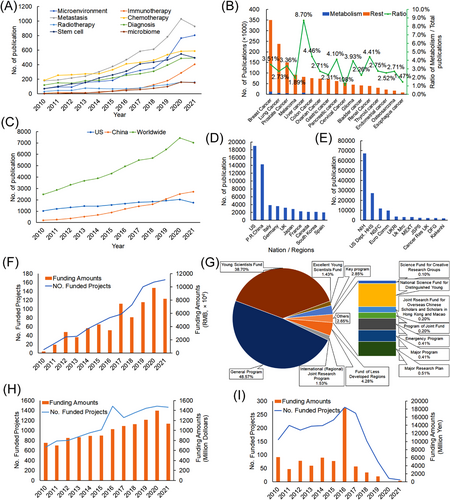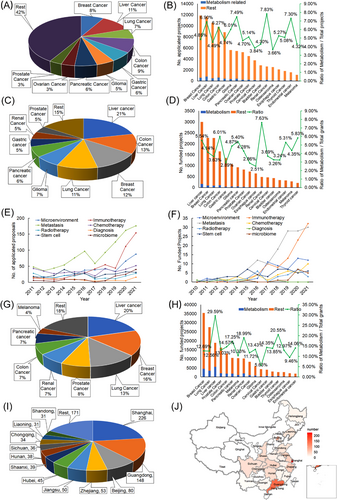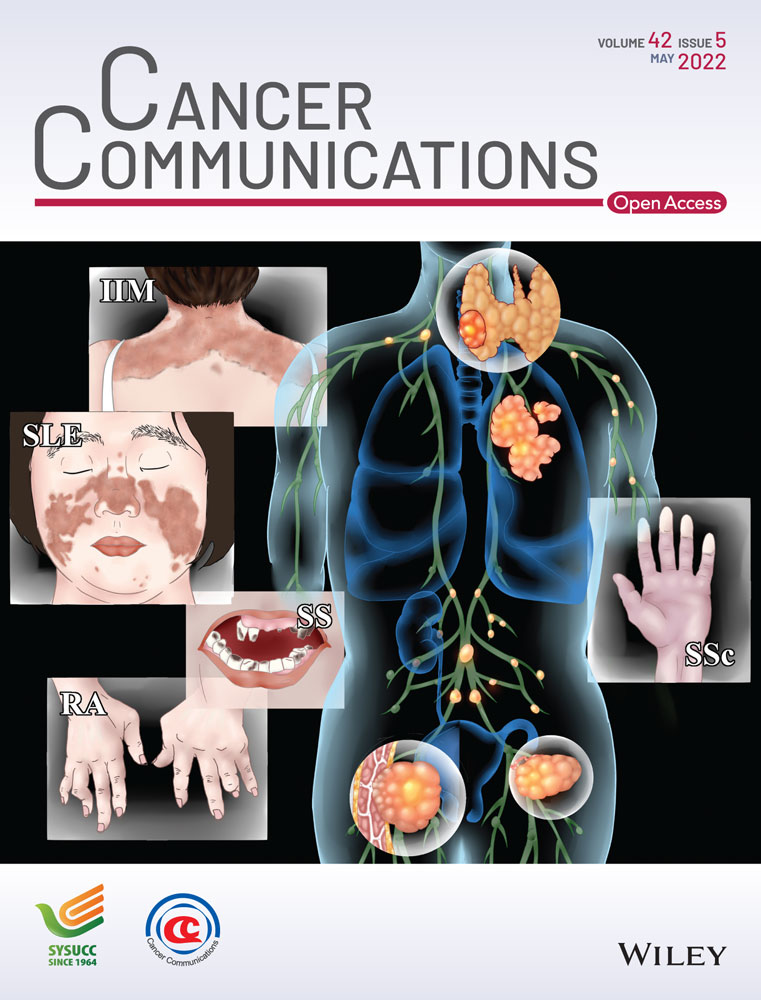Research trends of cancer metabolism: analysis from a Chinese perspective
Abbreviations
-
- FDA
-
- Food and Drug Administration
-
- IARC
-
- International Agency for Research on Cancer
-
- IDH1
-
- Isocitrate dehydrogenase 1
-
- IDH2
-
- Isocitrate dehydrogenase 2
-
- KAKENH
-
- Grants-in-Aid for Scientific Research
-
- NIH
-
- National Institute of Health
-
- NSFC
-
- National Natural Science Foundation of China
-
- PAF
-
- population attributable fraction
-
- UK
-
- United Kingdom
-
- US
-
- United States
-
- WCRF
-
- World Cancer Research Fund
1 INTRODUCTION
Association between aberrant metabolism and tumor progression has been discovered and studied for a long period of time, and reprogramming of metabolism has become one of the key characteristics of cancer cells [1, 2]. Numerous studies showed that metabolic disorders are closely related to cancer risk and cancer-related deaths [3]. According to the reports by the International Agency for Research on Cancer (IARC) and World Cancer Research Fund (WCRF), besides smoking, obesity and alcohol have become the most important risk factors of cancer worldwide [4]. When evaluated as population attributable fraction (PAF), the burden of cancer attributable to obesity was 11.9% in men and 13.1% in women. There is sufficient evidence for an association between excess body fatness and at least 13 cancer sites [5, 6]. In addition, alcohol consumption, insufficient physical activity, and dietary factors (i.e., insufficient fruit, non-starchy vegetables and fiber, red/processed meat, and salt) are postulated to dysregulate the metabolic axis and lead to metabolic syndrome [7], which has direct effects on health and increases the risk of developing cancer [8].
In China, dietary and lifestyle components are clearly important factors for high-frequency cancers. Adoption of modern lifestyles such as high-calorie and high-fat diet also contributed to the rise in several cancers, including pancreatic, colorectal, prostate, and female breast cancers [9]. In the United Kingdom (UK) and the United States (US), PAFs of obesity and alcohol are even higher [10]. Overweight and obesity is the second largest attributable cause, responsible for 6.3% of cancers in the UK. Alcohol (3.3%), dietary fiber (3.3%), and processed meat (1.5%) are also among the top 10 causes [4]. In Japan, however, where the prevalence of obesity is low, estimates of PAF were 1.1% for overweight and obesity and 6.3% for alcohol consumption (and 1.6% for salt) [11].
2 HOTSPOTS OF CANCER METABOLISM RESEARCH
Given that growing evidence suggest essential roles of metabolism in tumor progression, more scientists devote themselves in the basic research of this cutting-edge field. From 2010 to 2021, there are about 68,000 publications associated with cancer metabolism, and the scope of cancer metabolism has reached almost all subfields in oncology research, including cancer immunology, metastasis, chemotherapy, radiotherapy, diagnosis, and microenvironment. At this period, publications on cancer metastasis associated with metabolism accounted for the largest proportion (5,907 projects, 10.3%) of all papers related to cancer metabolism, followed by chemotherapy (4,593 projects, 8.0%) and microenvironment (3,774 projects, 6.6%) (Figure 1A). It is noteworthy that papers on cancer stem cell, microbiome, and immunotherapy have surged in recent years, indicating that these research fields are emerging hotspots. Among all these literature, 12,281 papers are on breast cancer research, followed by liver cancer (7,139) and lung cancer (6,457), closely paralleling the global epidemiological trends of cancer [12]. When the ratio of metabolism-related papers relative to the total research papers of each type of cancer are analyzed, metabolism of liver cancer, colon cancer, renal cancer as well as pancreatic cancer is highly concerned in each field (Figure 1B).

The significant growth of publications (From 2,400 to approximately 7,400 per year) indicates a rapid progress and extensive attention to cancer metabolism (Figure 1C). Notably, amount of China authored papers increased much more rapidly (average annual growth rate 28.3%) than the speed of the US authored papers (average annual growth rate 7.1%) and publications worldwide (average annual growth rate 11.6%) (Figure 1C). In sum, scholars from the US and China contributed the majority of these papers (33.1% and 24.9% of total published paper, respectively) (Figure 1D). Correspondingly, the Department of Health & Human Services, National Institute of Health (NIH) in the US and National Natural Science Foundation of China (NSFC) founded the most of these publications, followed by their counterparts in Europe and Japan (Figure 1E).
3 SCHEMES OF FUNDING RELATED TO CANCER METABOLISM
Fundamental research of disease in China is majorly supported by the central funders of the state, one of which is the NSFC. Since the Department of Health Sciences of NSFC was founded in 2010, both the number of projects and funding amounts related to cancer metabolism kept rising substantially (Figure 1F). From 2010 to 2021, the total number of cancer metabolism projects funded by the NSFC reached 982, with a total funding amount of 571.4 million RMB (US$ 88.76 million). Among these funded projects, 48.6% (477 projects) are “general programs”, which is a primary grant that allows scientists to freely select their research themes (Figure 1G). The second largest project type is the young scientist's grant (28.5%, 380 projects), which only support scholars not exceeding 35 years old for males or 38 years old for females. Besides, there are also 28 key programs, 5 major research plans, 5 major programs and 1 Science Fund for Creative Research Group, all support researchers to conduct in-depth, systematic and innovative research to promote disciplinary development and breakthroughs in the important area or scientific frontiers. Moreover, in this field, 8 scientists were supported by National Science Fund for Distinguished Young Scholars and 14 scientists received Excellent Young Scientists Fund, which support young scholars who have made outstanding achievements in basic research. In comparison, between 2010 and 2021, NIH funded a total number of 13,621 projects related to the field of cancer metabolism, with an overall funding amount of US$ 11.94 billion (Figure 1H). In Japan, the numbers and amounts of grants allotted for cancer metabolism research by the national Grants-in-Aid for Scientific Research (KAKENHI) Program were 1,986 and 55.79 billion Yen (US$ 48.90 million), respectively (Figure 1I). It is noteworthy that there is an obvious decline in numbers and amounts of cancer metabolism grants after 2016 in Japan, despite that the overall budget of KAKENHI remains steady.
When the cancer types of NSFC submitted proposals and awarded grants were investigated, from 2010 to 2021, there were more than 7,000 submitted proposals related to cancer metabolism, among which liver cancer-related metabolism accounted for the majority (804 proposals) of all cancer metabolism proposals, followed by colon cancer (614 projects) and breast cancer (576 proposals) (Figure 2A). Of all the cancer types, renal cancer and pancreatic cancer have the highest ratio of metabolism-related proposals relative to overall proposals, while bladder cancer (4.30%), cervical cancer (3.84%) and osteosarcoma (3.66%) hold relative lower ratios (Figure 2B). This trend of applications mirrors that of the publications, as well as that of the funded projects, among which projects funded on liver cancer are also the most (166 projects) of all cancer metabolism projects, followed by colon cancer (99 projects) and breast cancer (94 projects) (Figure 2C). As for the cancer types, renal cancer has the highest proportion of grants funded for metabolism-related projects relative to all funded renal cancer projects (7.63%), which is slightly higher than colon cancer (6.01%) and thyroid cancer (5.83%), while gastric cancer (2.89%), ovarian cancer (2.85%) and esophageal cancer (2.51%) have relative lower ratios of metabolism-related projects (Figure 2D). When the subjects of these proposals/projects are analyzed, projects (proposals) on metastasis accounted for the most of all cancer metabolism projects (proposals), followed by immunotherapy, which increased significantly in recent years (Figure 2E and F). During the same period, the composition of research fields funded by the NIH was rather different, with liver cancer- (5,606 projects), breast cancer- (4,495 projects), and lung cancer-related projects (3,469 projects) accounting for approximately 49% of all awarded cancer metabolism projects (Figure 2G). In comparison with the case of NSFC, the ratio of NIH-supported metabolism-related projects relative to all cancer projects was strikingly higher (5.00%-30.00%, respectively), with liver cancer (29.60%), thyroid cancer (20.50%), and renal cancer (19.00%) being the leading cancer types, while cervical cancer (5.63%), esophageal cancer (9.48%), and melanoma (10.33%) have the lowest proportion of metabolism-related projects (Figure 2H).

Over the past ten years, 134 out of 2,828 (4.7%) registered research institutions in China have been funded by the NSFC in the field of cancer metabolism. Most of these institutions are distributed in the mega cities of China. For instance, Shanghai, Guangzhou and Beijing share over 46.2% of the total funding awarded for cancer metabolism by the NSFC (Figure 2I and J). Despite that NSFC has approved 42 cancer metabolism projects of “Fund of Less Developed Regions” (Figure 1G) to promote the scientific research of these areas, the unbalanced R&D ability across the state is still an issue that needs to be concerned by the national funding organizations.
4 PERSPECTIVES
The past decade has witnessed a dramatic improvement in the diagnosis and treatment of malignant tumors. Incidence and mortality rates of certain types of cancer (such as some infection-related cancers) have steadily declined. Meanwhile, the prevalence of metabolism-related cancer (such as cancer of the digestive system, e.g., colon cancer and pancreatic cancer) rise drastically, especially in the emerging economies such as China, at least in part attributable to a transition to less healthy lifestyles. Progress on the metabolic deregulation of cancer provides the possibilities of targeting crucial biochemical pathways and improving the prognosis of multiple malignancies. The Warburg effect of cancer cells is clinically exploited to detect increased uptake of the radiolabeled glucose analogue 18F-fluoro-2-deoxy-D-glucose by tumors compared with normal tissues, which is currently widely used for cancer diagnosis and monitoring [13]. In addition, both dietary and pharmacologic therapeutics that target aberrant metabolism are also considered for cancer treatment. Dietary interventions such as short-term fasting and ketogenic diets, which usually induce the reduction of glycemia and insulinemia while rising of ketones, are considered helpful in limiting the adverse effects of chemotherapy and tumor proliferation [14]. Recently, investigation of gut microbiota suggests its essential role in regulating the antitumor effect of chemotherapy [15] and immunotherapy [16]. Other metabolism-targeting pharmacologic therapies including metformin, aspirin, and drugs that target specific metabolic pathways are proved to have promising prevention and preclinical effects on cancer. On the other hand, there is now an appreciation of how the metabolic constraints imposed by the tumor microenvironment [17], targeting the metabolism of stroma cells, especially the immune cells within the cancer microenvironment, may also contribute to improving the efficacy of the current immunotherapy [18, 19]. However, despite that isocitrate dehydrogenase 1 (IDH1) inhibitor ivosidenib and isocitrate dehydrogenase 2 (IDH2) inhibitor enasidenib were approved by the U.S. Food and Drug Administration (FDA) for treatment of relapsed/refractory acute myeloid leukemia patients with IDH1 and IDH2 mutations, respectively, most novel metabolism-targeting drugs are still at preclinical studies and clinical trials [14, 20]. Finding and focusing on the approaches to improve more selective effects are still challenging.
Cancer research, including metabolism-related research, in China has achieved remarkable progress in the current century, although the total amount and the proportion of NFSC projects funded for metabolism cancer are still less than the proportion of NIH funded projects. As demonstrated in the current paper, both grants and publications from China that related to cancer metabolism have become 2nd of the world, including more studies meriting publication in elite journals. Continuous government investment in fundamental research is definitely the major driving force behind this rapid growth. However, high-level translational medicine in this field research is still limiting. Funding institutions including NSFC might need to shift their policies, mainly about (i) increasing financial aid, especially the development of multi-source support, to narrow the gap between the increasing contribution of metabolism to cancer epidemiology and limited funding inputs; (ii) encouraging projects with an emphasis on translational innovations; and (iii) increasing the scientific funding expenditure and support rate for relatively less developed areas.
In general, the prevalence and thus burden of cancer are still heavy both in China and globally, regardless of the research progressions in recent years, among which metabolism-associated cancers have emerged as a major threat to health and quality of life. Analysis regarding the hot areas of cancer metabolism indicates a slight difference between publications and grants. According to the latest achievements reflected by the publications especially in the elite journals, some subfields in cancer metabolism, which include tumor metabolite sensing and signaling, tumor metabolism and epigenetics, metabolic reprogramming in tumor microenvironment remodeling, metabolic vulnerabilities in cancer, and targeting immunometabolism for cancer therapy, reflect the cutting-edge of cancer metabolism research and necessarily draw more attention from funding agencies.
DECLARATIONS
ETHICS APPROVAL AND CONSENT TO PARTICIPATE
Not applicable.
CONSENT FOR PUBLICATION
Not applicable.
AVAILABILITY OF DATA AND MATERIALS
All information collected from public resources are described in the figure legends. Data regarding NSFC grants related to the current study is available upon request.
COMPETING INTERESTS
All authors declare no conflict of interests.
FUNDING
Not applicable.
AUTHORS' CONTRIBUTIONS
Conceptualization: Rong Shi. Data collection and analysis: Yang Li, Jun Liu, Lichao Sun, and Bin Zhang. Visualization: Yang Li. Supervision: Rong Shi. Manuscript writing: Yang Li. Manuscript writing, reviewing, and editing: Yang Li and Rong Shi.
ACKNOWLEDGEMENTS
Not applicable.




